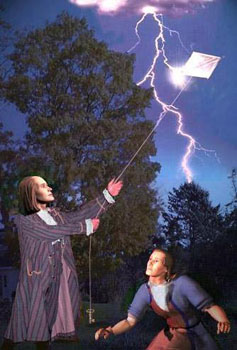Benjamin Franklin And The Kite
|
| updated |
Copy Link Code
|
 For all his contributions to politics, literature and science, the aspect of Benjamin Franklin's life that grabs the most attention is certainly his experiment flying a kite in a lightning storm. It was in 1750 that Franklin first proposed an experiment for drawing electricity from the clouds of a storm with the use of a kite. In 1752, French scientist Thomas-Francois Dalibard performed a similar experiment with a 40-ft tall iron rod and was successful. In June of that year, Ben Franklin's kite would have its own attempt. With a copper key attached to a wet kite, Franklin drew sparks from the clouds and conserved the charge; when he returned home, he was able to transfer the charge into a glass globe, thus demonstrating that the lightning was electric. Although Franklin did produce instructions for duplicating his experiment safely, some imitators managed to electrocute themselves while others were successful. In 1767, Joseph Priestley published The History and Present Status of Electricity giving credit to Benjamin Franklin's kite experiment for advancing the study of electricity in nature.
For all his contributions to politics, literature and science, the aspect of Benjamin Franklin's life that grabs the most attention is certainly his experiment flying a kite in a lightning storm. It was in 1750 that Franklin first proposed an experiment for drawing electricity from the clouds of a storm with the use of a kite. In 1752, French scientist Thomas-Francois Dalibard performed a similar experiment with a 40-ft tall iron rod and was successful. In June of that year, Ben Franklin's kite would have its own attempt. With a copper key attached to a wet kite, Franklin drew sparks from the clouds and conserved the charge; when he returned home, he was able to transfer the charge into a glass globe, thus demonstrating that the lightning was electric. Although Franklin did produce instructions for duplicating his experiment safely, some imitators managed to electrocute themselves while others were successful. In 1767, Joseph Priestley published The History and Present Status of Electricity giving credit to Benjamin Franklin's kite experiment for advancing the study of electricity in nature.
Benjamin Franklin's study of electricity involved much more than the nature of lightning. He was the first scientist to label the two forms of electricity as "positive" and "negative" instead of "vitreous" and "resinous", noting that the main difference seemed to be the pressure on the current. He was also the first to establish the concept of conservation of charge, which he utilized during the kite experiment. Franklin was known as a very pragmatic inventor and his experience with the kite experiment led him to crafting the world's first lightning rod. After experimenting with one on his own home, Franklin oversaw the installation of lightning rods on the campus of his Academy of Philadelphia (later known as the University of Pennsylvania) as well as the Pennsylvania State House (soon to become Independence Hall). The premise of Franklin's lightning rod was that the electricity from a strike would be drawn into a sharpened pole at the top of the building and safely down a wire to the ground. The importance of a sharp point was established during his previous experiments which showed that a sharpened point would be quieter and effective at longer distances than a dull one.
The image of Benjamin Franklin flying a kite has become iconic in the history of innovation in the United States. Depictions of Benjamin Franklin and the kite have been replicated around the world, including a commemorative stamp from the Soviet Union celebrating Franklin's contributions to science produced in 1956, the 250th anniversary of his birth. Franklin himself was aware that he lived in an era that was unfortunately too early to enjoy the possibilities of electrical convenience in industry and daily life. He foresaw the ubiquity of electricity that we now enjoy and was certainly jealous. Franklin was invited to meet the King of France and explain his vision of that future after the fame of his experiment spread. The Benjamin Franklin kite experiment demonstrated the daring and genius of America's first great polymath and an influential Founding Father.
